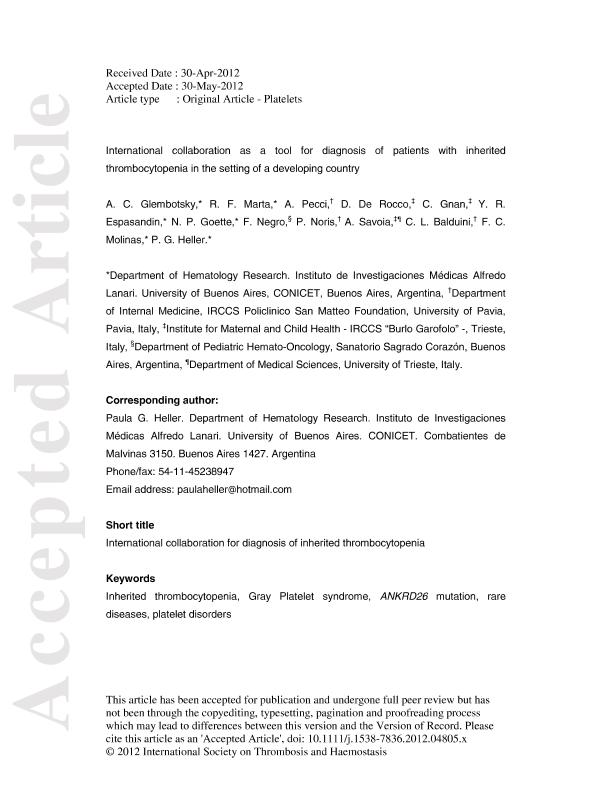Artículo
International collaboration as a tool for diagnosis of patients with inherited thrombocytopenia in the setting of a developing country
Glembotsky, Ana Claudia ; Marta, Rosana Fernanda
; Marta, Rosana Fernanda ; Pecci, Alessandro; de Rocco, Daniela; Gnan, Chiara; Espasandin, Yesica Romina
; Pecci, Alessandro; de Rocco, Daniela; Gnan, Chiara; Espasandin, Yesica Romina ; Goette, Nora Paula
; Goette, Nora Paula ; Negro, F.; Noris, Patrizia; Savoia, Anna; Balduini, C. L.; Molinas, Felisa Concepción
; Negro, F.; Noris, Patrizia; Savoia, Anna; Balduini, C. L.; Molinas, Felisa Concepción ; Heller, Paula Graciela
; Heller, Paula Graciela
 ; Marta, Rosana Fernanda
; Marta, Rosana Fernanda ; Pecci, Alessandro; de Rocco, Daniela; Gnan, Chiara; Espasandin, Yesica Romina
; Pecci, Alessandro; de Rocco, Daniela; Gnan, Chiara; Espasandin, Yesica Romina ; Goette, Nora Paula
; Goette, Nora Paula ; Negro, F.; Noris, Patrizia; Savoia, Anna; Balduini, C. L.; Molinas, Felisa Concepción
; Negro, F.; Noris, Patrizia; Savoia, Anna; Balduini, C. L.; Molinas, Felisa Concepción ; Heller, Paula Graciela
; Heller, Paula Graciela
Fecha de publicación:
08/2012
Editorial:
Wiley Blackwell Publishing, Inc
Revista:
Journal of Thrombosis and Haemostasis
ISSN:
1538-7933
Idioma:
Inglés
Tipo de recurso:
Artículo publicado
Clasificación temática:
Resumen
Inherited thrombocytopenias (ITs) are heterogeneous genetic disorders that frequently represent a diagnostic challenge. The requirement of highly specialized tests for diagnosis represents a particular problem in resourcelimited settings. To overcome this difficulty, we applied a diagnostic algorithm and developed a collaboration program with a specialized international center in order to increase the diagnostic yield in a cohort of patients in Argentina. Methods: Based on the algorithm, initial evaluation included collection of clinical data, platelet size, blood smear examination and platelet aggregation tests. Confirmatory tests were performed according to diagnostic suspicion, which included platelet glycoprotein expression, immunofluorescence for myosin- 9 in granulocytes and platelet thrombospondin-1 and molecular screening of candidate genes. Results: Thirty-one patients from 14 pedigrees were included; their median age was 32 (4?72) years and platelet count 72 (4?147) · 109 L)1. Autosomal dominant inheritance was found in nine (64%) pedigrees; 10 (71%) had large platelets and nine (29%) patients presented with syndromic forms. A definitive diagnosis was made in 10 of 14 pedigrees and comprised MYH9-related disease in four, while classic and monoallelic Bernard?Soulier syndrome, gray platelet syndrome, X-linked thrombocytopenia, thrombocytopenia 2 (ANKRD26 mutation) and familial platelet disorder with predisposition to acute myelogenous leukemia were diagnosed in one pedigree each. Conclusions: Adoption of an established diagnostic algorithm and collaboration with an expert referral center proved useful for diagnosis of IT patients in the setting of a developing country. This initiative may serve as a model to develop international networks with the goal of improving diagnosis and care of patients with these rare diseases.
Archivos asociados
Licencia
Identificadores
Colecciones
Articulos(IDIM)
Articulos de INST.DE INVEST.MEDICAS
Articulos de INST.DE INVEST.MEDICAS
Citación
Glembotsky, Ana Claudia; Marta, Rosana Fernanda; Pecci, Alessandro; de Rocco, Daniela; Gnan, Chiara; et al.; International collaboration as a tool for diagnosis of patients with inherited thrombocytopenia in the setting of a developing country; Wiley Blackwell Publishing, Inc; Journal of Thrombosis and Haemostasis; 10; 8; 8-2012; 1653-1661
Compartir
Altmétricas



